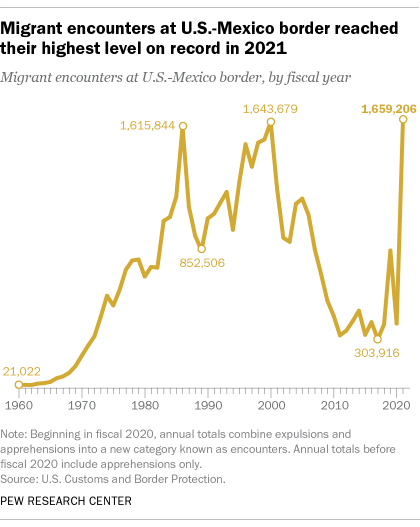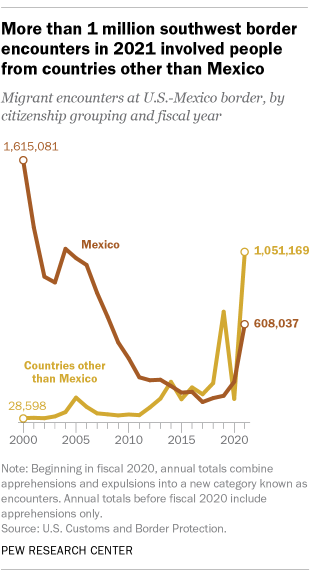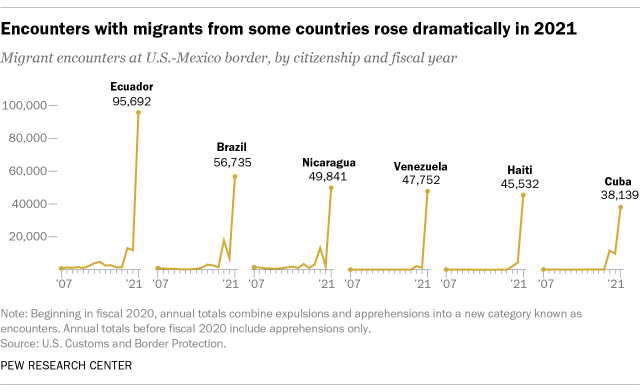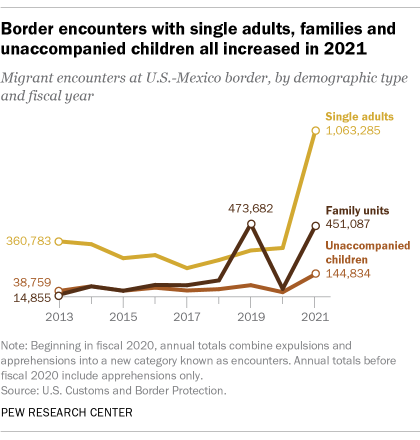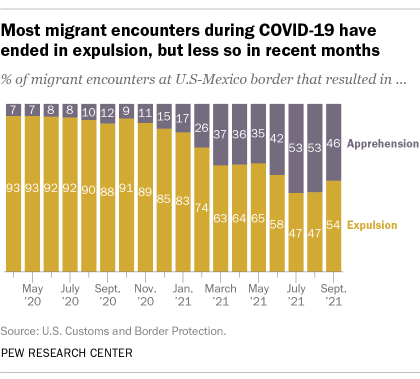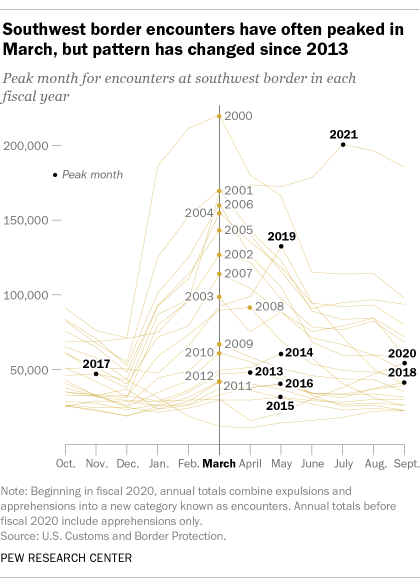
The U.S. Border Patrol reported more than 1.6 million encounters with migrants along the U.S.-Mexico border in the 2021 fiscal year, more than quadruple the number of the prior fiscal year and the highest annual total on record.
The number of encounters had fallen to just over 400,000 in fiscal 2020 as the coronavirus outbreak slowed migration across much of the world. But encounters at the southwest border rebounded sharply in fiscal 2021 and ultimately eclipsed the previous annual high recorded in fiscal 2000, according to recently published data from U.S. Customs and Border Protection (CBP), the federal agency that encompasses the Border Patrol.
Migrant encounters refer to two distinct kinds of events: expulsions, in which migrants are immediately expelled to their home country or last country of transit, and apprehensions, in which migrants are detained in the United States, at least temporarily.
Since the onset of the coronavirus pandemic, most encounters have resulted in expulsion from the U.S., unlike before the pandemic, when the vast majority ended in apprehension instead. The Trump administration began expelling migrants in March 2020 under a public health order aimed at limiting the spread of COVID-19. The Biden administration has continued to expel migrants under the same order.
Below is a closer look at the shifting dynamics at the southwest border, based on the recent CBP statistics. Most of these statistics refer to federal fiscal years, which run from Oct. 1 to Sept. 30, as opposed to calendar years. It’s also important to note that encounters refer to events, not people, and that some migrants are encountered more than once.
This Pew Research Center analysis examines changing migration patterns at the U.S.-Mexico border, based on current and historical data from U.S. Customs and Border Protection (CBP). The analysis is based on migrant encounters – a common but only partial indicator of how many people enter the United States illegally in a given year.
Encounters refer to two distinct kinds of events: expulsions, in which migrants are immediately expelled to their home country or last country of transit, and apprehensions, in which migrants are detained in the U.S., at least temporarily. Since March 2020, encounter statistics have included expulsions carried out under Title 42, a public health order aimed at limiting the spread of COVID-19. Encounter statistics prior to March 2020 include apprehensions only.
It is important to note that encounters refer to events, not people, and that some migrants are encountered more than once. In fact, repeat border crossers have accounted for a sizable proportion of total encounters in recent years. As a result, the number of encounters overstates the number of distinct individuals involved.
Most of the findings in this analysis refer to federal fiscal years, which run from Oct. 1 to Sept. 30, as opposed to calendar years. Due to data limitations, not all findings in this analysis cover the same time period. CBP statistics on total southwest border encounters are available for the 1960-2021 period, for example, while statistics on the demographic profile of those being encountered are available only for the 2013-2021 period.
This analysis only includes encounters reported by the U.S. Border Patrol. It excludes encounters reported by the Office of Field Operations.
Southwest border encounters increased to their highest recorded level in fiscal 2021. The Border Patrol reported 1,659,206 encounters with migrants at the U.S.-Mexico border last fiscal year, narrowly exceeding the prior highs of 1,643,679 in 2000 and 1,615,844 in 1986.
The large number of encounters in fiscal 2021 dwarfed the total during the last major wave of migration at the southwest border, which occurred in fiscal 2019. The Border Patrol recorded 851,508 encounters that year.
While the number of encounters was the highest on record last fiscal year, the number of individuals encountered was considerably lower. That’s because more than a quarter of all migrant encounters at U.S. borders in both fiscal 2021 and fiscal 2020 (27% and 26%, respectively) involved repeat crossers, according to CBP statistics. By comparison, the proportion of repeat border crossers was much lower in the 2019 fiscal year (7%), before the Border Patrol began regularly expelling migrants during the coronavirus outbreak. (These recidivism statistics include encounters at all U.S. borders. While separate statistics for only the U.S.-Mexico border are not available, encounters at the southwest border have accounted for more than 97% of total encounters in recent years.)
A record number of encounters in fiscal 2021 involved people from countries other than Mexico. Mexico was the single most common origin country for migrants encountered at the border in fiscal 2021. The Border Patrol reported 608,037 encounters with Mexican nationals last year, accounting for 37% of the total. The remaining 1,051,169 encounters, or 63%, involved people from countries other than Mexico – by far the highest total for non-Mexican nationals in CBP records dating back to 2000.
Most of the encounters with non-Mexicans in fiscal 2021 involved people from the Northern Triangle countries of Honduras, Guatemala and El Salvador. There were 308,931 encounters with people from Honduras last fiscal year (representing 19% of all encounters), 279,033 with people from Guatemala (17%) and 95,930 with people from El Salvador (6%). The Northern Triangle region has been a major source of migration at the U.S-Mexico border in recent years.
Encounters soared in fiscal 2021 for some countries that have not historically been common sources of migration at the U.S.-Mexico border. The number of encounters involving people from Ecuador, for example, increased more than eightfold, from 11,861 in fiscal 2020 to 95,692 in fiscal 2021. There were also stark increases in encounters involving people from Brazil (from 6,946 to 56,735), Nicaragua (from 2,123 to 49,841), Venezuela (from 1,227 to 47,752), Haiti (from 4,395 to 45,532) and Cuba (from 9,822 to 38,139).
Economic, social and political instability in some of these countries likely played a role in the spike in encounters at the U.S.-Mexico border last fiscal year. In Ecuador, widespread economic problems and the COVID-19 pandemic have led many migrants to make the journey north. Haiti, meanwhile, has faced a number of challenges in recent years, ranging from natural disasters to the assassination of its president in July.
Related: Biden administration widens scope of Temporary Protected Status for immigrants
The increase in encounters at the U.S.-Mexico border didn’t just involve people from Latin America or the Caribbean region. The number of encounters involving people from Romania rose from 266 in fiscal 2020 to 4,029 in fiscal 2021, while the number involving people from Turkey increased from 67 to 1,366.
Migrant encounters increased across demographic groups in fiscal 2021, but single adults continued to account for the large majority. Encounters with unaccompanied children rose from 30,557 in fiscal 2020 to 144,834 in fiscal 2021, while encounters with people traveling in families increased from 52,230 to 451,087.
By far the largest number and share of encounters involved single adults. There were 1,063,285 encounters with single adults in fiscal 2021, up from 317,864 the year before. More than six-in-ten encounters (64%) involved single adults, though that was down from 79% in fiscal 2020.
Migrant encounters more than doubled in every sector along the U.S.-Mexico border in fiscal 2021. The largest numerical increase occurred in the Rio Grande Valley sector, where there were 549,077 encounters last fiscal year, up from 90,206 the year before. But the largest proportional increase occurred in the Yuma sector, where encounters increased thirteenfold, from 8,804 in fiscal 2020 to 114,488 in fiscal 2021.
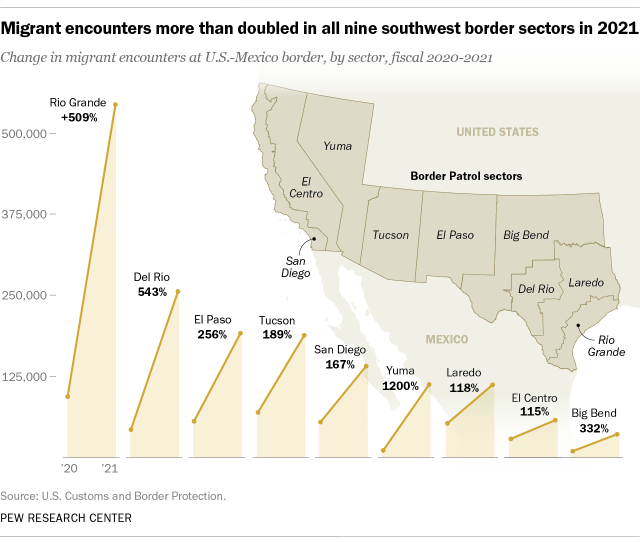
Since the coronavirus outbreak began, most migrant encounters have resulted in expulsion from the U.S., rather than apprehension within the country. In March 2020, the administration of former President Donald Trump invoked Title 42, a public health order allowing the Border Patrol to expel migrants immediately in an effort to control the domestic spread of the coronavirus. President Joe Biden’s administration has continued to expel migrants under Title 42, though to a lesser extent than the Trump administration.
About two-thirds (66%) of all migrant encounters ended in expulsion between April 2020, the first full month after Title 42 was invoked, and September 2021, the end of the 2021 fiscal year. The remaining 34% resulted in apprehension. But the share of encounters resulting in expulsion has decreased under the Biden administration. In September 2021, 54% of encounters ended in expulsion, down from 74% in February 2021, the first full month after Biden took office.
Seasonal migration patterns have changed in recent years. Since 2000, border encounters have typically peaked in the spring – most often in March – before declining during the hot summer months, when migration journeys become more perilous. But the pattern has changed since 2013, with the annual peak occurring in months other than March. July was the peak month in fiscal 2021, with the number of encounters (200,658) far exceeding the total recorded in March (169,216), even though temperatures in July are typically much higher.
Note: This is an update of a post originally published on April 10, 2019.
